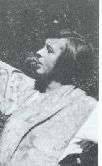Erika Giovanna Klien
Erika Giovanna Klien (12 April 1900 – 19 July 1957) was an artist and art educator.
Erika Giovanna Klien | |
|---|---|
 | |
| Born | April 12, 1900 Borgo Valsugana, Italy |
| Died | July 19, 1957 (aged 57) New York, New York |
| Nationality | Italian-American |
| Education | Vienna School of Applied Arts |
| Known for | Painting |
| Movement | Kinetism |
Career
Erika Giovanna Klien began her studies at the Vienna School of Applied Arts, also known as Kunstgewerbeschule Wien in Vienna, Austria in 1919 and graduated in 1925.[1] She was a student of Dr. Franz Cizek and became one of his teaching assistants at his Juvenile Art Class. In Cizek's course, Theory of Ornamental Form, Klien was introduced to a new style known as Viennese Kinetism. Kinetism emphasized movement and modern vitality, in a way similar to French Cubism, Italian Futurism and Russian Constructivism.[2] She developed the technique and theories of Kinetism throughout her artistic life and became its leading exponent.[1]
Cizek included her in several international exhibitions, including the Paris Decorative Arts Exhibition of 1925 and the International Exhibition of Modern Art in New York City in 1927. After graduation, Klien found it difficult, as did many women, to earn a living as an independent artist. She worked as a commercial graphic artist and taught at the Elizabeth Duncan School, at Klessheim near Salzburg, from 1926 to 1928.[1] She exhibited her work at the Fourth International Congress of Art Education in Prague in 1928.[3]
In 1929 Klien sailed for the United States, bringing with her hopes for an artistic career and the reform theories of children's art education she had acquired in Vienna.[2] She worked at New York’s Stuyvesant High School, Spence School, Dalton School and the Walt Whitman School, among others. To earn a living for herself and her son, she taught simultaneously at three institutions from 1930 to 1940.[1]
Personal life
Klien was born April 12, 1900 in Borgo Valsugana, Trentino, Italy. In 1928, unmarried, she had a son, whom she kept secret from her family. In 1929 she moved to the United States. Klien's son Walter Klien (27 November 1928 in Graz, Austria – 10 February 1991) became a pianist. In 1938 Klien became a U. S. citizen. She died on 19 July 1957 from a heart attack in New York City.[1]
Exhibitions
- 1930: The New School for Social Research, New York[4]
- 1975: Galerie Pabst, Vienna[4]
- 1986: Retrospective at Gallery Pabst, Munich
- 1987: Museum des XX. Jahrhunderts (Museum of the 20th Century), Vienna (250 works)
- 1989: Rachel Adler Gallery, New York[4]
- 2001: Bolzano
- 2006: Société Anonyme at the Hammer, reviewed in The Aesthetic
- Permanently: Phillips Collection Art Museum in Washington, DC.